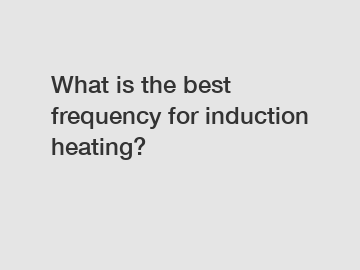Induction heating is a versatile and efficient method of heating metals or other conductive materials. It utilizes electromagnetic induction to heat the material quickly and uniformly. One of the important factors in determining the effectiveness of induction heating is the frequency at which the equipment operates. The frequency of induction heating systems can vary widely, and each frequency has its advantages and disadvantages depending on the application. In this article, we will explore the different frequencies used in induction heating and discuss which frequency is best for various applications.
### Low Frequency Induction Heating.
Low-frequency induction heating systems operate at frequencies below 10 kHz. These systems are typically used for heating larger parts or materials that require deeper penetration of the heat. Low-frequency systems are ideal for applications where heating a large area evenly is important, such as preheating for forging or heat treating large components.

Low-frequency induction heating has the advantage of deep heat penetration, which can be beneficial for heating thick materials. However, these systems are generally less efficient compared to higher frequency systems and can be less precise in controlling the heating process. Low frequencies also tend to produce more heat loss, which can lead to lower overall system efficiency.
### Medium Frequency Induction Heating.
Medium-frequency induction heating systems operate at frequencies between 10 kHz and 100 kHz. These systems are the most commonly used in industrial applications due to their versatility and efficiency. Medium-frequency systems are well-suited for a wide range of applications, including surface hardening, brazing, and melting.
Medium-frequency induction heating offers a good balance between heat penetration and efficiency. These systems are able to heat materials quickly and precisely, making them ideal for applications where control over the heating process is critical. Medium-frequency systems also have lower operating costs compared to low-frequency systems, making them a cost-effective choice for many industrial applications.
### High Frequency Induction Heating.
High-frequency induction heating systems operate at frequencies above 100 kHz. These systems are typically used for heating smaller parts or materials that require fast heating and precise control. High-frequency systems are ideal for applications such as soldering, brazing, and rapid heat treatment.
High-frequency induction heating offers the advantage of fast heating rates and precise temperature control. These systems are able to heat materials quickly and accurately, making them ideal for applications where speed and consistency are important. However, high-frequency systems may have limited penetration depth, which can be a drawback for some applications that require deeper heat penetration.
### Choosing the Best Frequency for Your Application.
When selecting the best frequency for your induction heating application, it is important to consider the size and shape of the material being heated, the desired heating rate, and the required temperature uniformity. Low frequencies are best suited for heating large parts with deep heat penetration, while high frequencies are ideal for fast heating of smaller parts with precise control. Medium frequencies offer a good balance between heat penetration and efficiency, making them suitable for a wide range of applications.
In conclusion, the best frequency for induction heating depends on the specific requirements of your application. By carefully considering the factors mentioned above, you can select the frequency that will provide the most efficient and effective heating process for your needs.
If you have any questions about induction heating frequencies or would like more information on our induction heating systems, please contact us.
Are you interested in learning more about induction forge coils, shrink fitting induction, china induction furnace capacitor factory? Contact us today to secure an expert consultation!





Comments
0